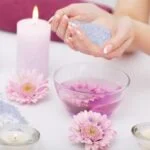Lavender oil has been a staple in the world of aromatherapy for centuries, cherished for its calming and soothing properties. In this article, we will delve into the various aspects of using aromatherapy lavender oil, including its history, benefits, and practical application. Discover how to use aromatherapy lavender oil to enhance relaxation and promote overall well-being.
The origins of lavender oil in aromatherapy date back to ancient civilizations, where it was valued for its aromatic scent and potential healing properties. Today, lavender oil continues to be a popular choice for promoting relaxation and stress relief. As we explore the benefits of lavender oil, we will also discuss its diverse uses in aromatherapy, from creating a tranquil atmosphere at home to incorporating it into massage therapy and sleep routines.
With an array of lavender oil products available in the market, it can be overwhelming to choose the right type for your needs. Understanding the different forms of lavender oil, such as essential oil, absolute, and hydrosol, is essential. We will guide you through selecting the most suitable lavender oil for your preferences and purposes in this introductory section.
Choosing the Right Type of Lavender Oil
When it comes to choosing lavender oil for aromatherapy, it’s important to understand that not all types of lavender oil are the same. There are several different varieties available in the market, each with its own unique properties and uses. In this section, we will delve into the different types of lavender oil and help you determine which one is best suited for your needs.
Different Types of Lavender Oil
There are a few main types of lavender oil that you may come across when shopping for aromatherapy products. These include essential oil, absolute, and hydrosol. Essential oil is the most commonly used type and is obtained through steam distillation of the lavender flowers. It is highly concentrated and potent, making it ideal for therapeutic uses such as promoting relaxation and relieving stress.
Absolute lavender oil is another type that is extracted using a solvent extraction method. It has a slightly different fragrance profile compared to essential oil and is often used in perfumery or skincare products. Hydrosol, on the other hand, is produced during the steam distillation process alongside essential oil. It is a much gentler option and can be used as a facial mist or added to bath water for a subtle scent.
How to Use Aromatherapy Lavender Oil
When using lavender oil in aromatherapy, it’s essential to choose the right type based on your intended use and personal preferences. Whether you’re looking for a highly potent option for therapeutic benefits or a gentle alternative for skin care applications, understanding the differences between these types of lavender oil will help you make an informed decision on which one to incorporate into your wellness routine.
Methods of Application
Aromatherapy lavender oil is a versatile essential oil that can be used in various ways to promote relaxation, reduce stress, and improve overall well-being. Knowing how to use aromatherapy lavender oil effectively is essential for reaping its benefits. In this section, we will explore the different methods of application for incorporating lavender oil into your aromatherapy routine.
One of the most common ways to use aromatherapy lavender oil is through diffusion. This method involves dispersing the scent of lavender oil into the air using a diffuser. Inhalation of the aromatic molecules can help calm the mind and relax the body, making it an excellent option for creating a peaceful atmosphere at home or in a therapeutic setting.
In addition to diffusion, topical application of lavender oil is another popular method. When diluted with a carrier oil such as coconut or almond oil, lavender oil can be applied directly to the skin for massage or targeted relief.
It’s important to conduct a patch test before using undiluted lavender oil on the skin to avoid any potential sensitivities or reactions. Lastly, some individuals may choose to ingest small amounts of high-quality culinary-grade lavender oil for its potential digestive and calming properties; however, this should only be done under the guidance of a qualified aromatherapist or healthcare practitioner.
It’s important to understand that while using aromatherapy lavender oil can provide numerous benefits, it is essential to do so safely and responsibly. Proper dilution and adherence to recommended usage guidelines are crucial in preventing adverse reactions. Whether you choose diffusion, topical application, or ingestion, always ensure that you are well informed on how best to use aromatherapy lavender oil for your specific needs.
| Method | Description |
|---|---|
| Diffusion | Dispersion of aromatic molecules into the air using a diffuser |
| Topical Application | Diluted application onto skin for massage or targeted relief |
| Ingestion (if safe) | Potential ingestion under professional guidance for specific benefits |
DIY Lavender Oil Recipes
Aromatherapy lavender oil is a versatile essential oil that can be used in a variety of do-it-yourself (DIY) recipes to create homemade products for relaxation, stress relief, and overall well-being. By making your own lavender oil products, you can customize the scents and ingredients to suit your preferences while also tapping into the therapeutic benefits of this aromatic oil.
One popular DIY lavender oil recipe is creating bath salts for a luxurious and calming bath experience. To make lavender-infused bath salts, simply combine Epsom salt or sea salt with a few drops of lavender essential oil. You can also add dried lavender buds or petals for added fragrance and visual appeal. Use these bath salts in warm bathwater to help promote relaxation and soothe tired muscles.
Another DIY recipe using aromatherapy lavender oil is crafting massage oils for at-home spa treatments. Mixing lavender essential oil with a carrier oil such as sweet almond oil or jojoba oil can create a soothing and aromatic massage blend. The calming properties of lavender oil can enhance the overall experience and provide additional benefits during massage sessions.
If you prefer to freshen up your living space with a pleasant scent, consider making your own room spray using lavender oil. Simply mix distilled water with witch hazel or vodka (as an emulsifier) and add several drops of lavender essential oil. Shake well before each use, then spritz the room spray in any area of your home to enjoy the calming and uplifting aroma of lavender.
When working with essential oils such as aromatherapy lavender oil, it’s important to take certain safety precautions into consideration. Always store homemade products in dark glass containers away from direct sunlight, as exposure to light can degrade the quality of the oils over time. Additionally, perform a patch test on a small area of skin before using any new product to ensure you do not have an adverse reaction.
Incorporating Lavender Oil Into Massage Therapy
Lavender oil has long been used in massage therapy for its relaxing and calming properties. When used in conjunction with massage, lavender oil can enhance the overall experience and provide additional benefits to the recipient. The gentle aroma of lavender combined with the soothing sensation of massage can create a serene and tranquil environment, perfect for promoting relaxation and stress relief.
When incorporating lavender oil into massage therapy, it is important to dilute the essential oil with a carrier oil, such as almond or coconut oil, to ensure it is safe for direct skin application. The recommended ratio for dilution is typically 3-5 drops of lavender oil per ounce of carrier oil. This allows the fragrance and therapeutic properties of the lavender oil to be effectively dispersed without overwhelming the senses or causing any adverse reactions.
Blending different carrier oils with lavender oil can also cater to specific needs or preferences. For example, using grapeseed oil as a carrier may result in a lighter texture that absorbs quickly into the skin, while coconut oil provides a more nourishing and moisturizing base for the massage. Experimenting with different carrier oils can enhance the overall massage experience and offer additional benefits beyond relaxation.
For an added touch, consider mixing lavender oil with other complementary essential oils to create a unique blend tailored to individual preferences or specific outcomes. Essential oils such as chamomile, bergamot, or clary sage can be combined with lavender oil to enhance its effects and create a more personalized aromatherapy experience during the massage session. However, it is important to perform a patch test before using any new blend to check for sensitivities or allergies.
Overall, incorporating lavender oil into massage therapy offers a multitude of benefits from creating an enjoyable sensory experience to promoting relaxation and stress relief. Whether used by professional masseuses or individuals practicing self-massage at home, adding this aromatic essential oil can elevate the overall therapeutic effect of massage sessions and contribute to enhanced well-being and tranquility.
In summary, using aromatherapy lavender oil in massage therapy requires careful consideration of proper dilution with carrier oils and potential blending with other essential oils. This approach aims to maximize the aromatic benefits without overwhelming sensitive individuals while catering to specific needs or personal preferences during each session. Incorporating lavender oil into massage allows practitioners and recipients alike how effective it can be in enhancing relaxation and reducing stress levels through its soothing properties.
Lavender Oil for Sleep and Relaxation
Lavender oil is widely recognized for its soothing and calming properties, making it a popular choice for promoting better sleep and relaxation. Here are some tips on how to use aromatherapy lavender oil specifically for achieving these benefits:
1. Bedtime Routine: One of the simplest ways to incorporate lavender oil into your bedtime routine is by adding a few drops to a cotton ball and placing it near your pillow. The subtle scent will help create a relaxing atmosphere, making it easier to unwind and fall asleep.
2. Bath Time Bliss: Create a luxurious and soothing bath experience by adding a few drops of lavender oil to your bath water. The warm water will help release the aroma of the oil, creating a spa-like ambiance that can help ease stress and tension before bedtime.
3. Diffuser Blends: Utilize an essential oil diffuser to spread the fragrance of lavender oil throughout your bedroom or living space. Consider blending lavender with other calming essential oils such as chamomile or ylang-ylang for an enhanced relaxation experience.
In addition to these methods, incorporating lavender oil into massage therapy can also be incredibly beneficial for promoting relaxation and reducing tension in the body. By diluting it with a carrier oil such as almond or jojoba, you can create a soothing massage blend that can be used during self-massage or professional massage sessions as well.
For those seeking natural remedies for better sleep and relaxation, learning how to use aromatherapy lavender oil effectively is an essential skill that can greatly contribute to overall wellness and quality of life. Whether utilized in diffuser blends, DIY home products, or incorporated into massage therapy, the calming properties of lavender oil offer endless possibilities for those looking to achieve restful sleep and stress relief.
Aromatherapy Diffuser Blends With Lavender Oil
Stress Relief Blend
To create a stress-relief blend using lavender oil, consider combining it with essential oils known for their calming properties such as chamomile, bergamot, and frankincense. Add a few drops of each essential oil to your diffuser along with water, and let the soothing aroma fill the room. This blend can be especially beneficial during times of high stress or anxiety.
Mood Enhancement Blend
For an uplifting and mood-enhancing blend, mix lavender oil with citrus essential oils like lemon, orange, or grapefruit. Citrus scents are known for their energizing and mood-boosting effects, while lavender adds a touch of tranquility to the mix. Diffuse this blend when you need a mental pick-me-up or want to infuse your surroundings with a sense of positivity.
Mental Clarity Blend
When looking to improve focus and concentration, consider blending lavender oil with stimulating essential oils like rosemary, peppermint, or eucalyptus. The combination of these invigorating scents with the calming presence of lavender can help clear the mind and enhance mental clarity. Diffuse this blend while working or studying to create an environment conducive to productivity.
By experimenting with different aromatherapy diffuser blends featuring lavender oil, you can discover which combinations work best for you in promoting overall well-being and creating a peaceful ambiance in your home or workspace. Using high-quality essential oils and following safety guidelines for diffuser use will ensure an enjoyable and effective aromatherapy experience.
Safety Precautions and Tips
When using aromatherapy lavender oil, it is essential to be aware of safety precautions and tips to ensure a positive and safe experience. Here are some important guidelines to consider when incorporating lavender oil into your aromatherapy routine:
- Proper Dilution: Lavender oil should always be diluted before applying it to the skin to prevent any potential irritation or adverse reactions. It is recommended to use a carrier oil, such as coconut oil or jojoba oil, when applying lavender oil topically. A general rule of thumb is to dilute 1-2 drops of essential oil per teaspoon of carrier oil.
- Sensitivities and Allergies: Before using lavender oil, it is crucial to perform a patch test on a small area of the skin to check for any sensitivities or allergic reactions. If you experience any redness, itching, or irritation, discontinue use immediately.
- Safe Storage: To maintain the potency and integrity of lavender oil, store it in a cool, dark place away from direct sunlight and heat. Proper storage can help extend the shelf life of the oil and prevent it from becoming rancid.
In addition to these safety precautions, there are also certain tips for handling lavender oil effectively:
- Use Caution with Ingestion: While some essential oils can be ingested in small amounts under the guidance of a qualified practitioner, it is generally recommended to avoid ingesting lavender oil without proper knowledge or supervision due to its high concentration.
- Keep Away from Children and Pets: Essential oils should be kept out of reach of children and pets, as they can be toxic if ingested in large quantities.
- Consult with a Professional: If you have any underlying health conditions, are pregnant or nursing, or are taking medication, it is advisable to consult with a healthcare professional before using lavender oil for aromatherapy purposes.
By following these safety precautions and tips when using aromatherapy lavender oil, you can enjoy its relaxing benefits while minimizing potential risks. It’s important to prioritize safety and responsible usage when incorporating essential oils into your wellness practices.
Conclusion and Next Steps
In conclusion, aromatherapy lavender oil has been used for centuries as a natural remedy for promoting relaxation, reducing stress, and improving overall wellbeing. Its versatile uses and benefits make it a must-have in any essential oil collection. From creating DIY products to incorporating it into massage therapy, there are numerous ways to use lavender oil to enhance your daily life.
As discussed in this article, choosing the right type of lavender oil is crucial in maximizing its benefits. Whether it’s essential oil, absolute, or hydrosol, understanding the differences and selecting the appropriate type for your needs is essential. Additionally, learning about the various methods of application such as diffusing, inhalation, topical application, and ingestion (if safe) will allow you to harness the full potential of lavender oil in aromatherapy.
As you explore the world of aromatherapy with lavender oil, always remember safety precautions and tips. Dilution, sensitivities, allergies, and proper storage are important considerations when using essential oils. By following these guidelines and embracing the benefits of aromatherapy lavender oil, you can experience its soothing effects on both body and mind. So go ahead and start experimenting with incorporating lavender oil into your daily routines – you just might discover a new level of relaxation and tranquility.
Frequently Asked Questions
Can You Apply Lavender Essential Oil Directly to Skin?
Yes, lavender essential oil can be applied directly to the skin, but it’s important to dilute it with a carrier oil first to avoid any potential irritation or adverse reactions. This can be done by mixing a few drops of lavender oil with a neutral carrier oil like coconut or almond oil before applying it to the skin.
Where Do You Put Lavender Oil for Calming?
Lavender oil can be put on different parts of the body for calming effects. Some common areas include the temples, wrists, or feet. When used in aromatherapy, diffusing lavender oil into the air can also help create a calming and relaxing atmosphere.
When Not to Use Lavender Essential Oil?
It’s important not to use lavender essential oil on infants or young children, as it can be too potent and may cause adverse reactions in their sensitive systems. Additionally, individuals with known allergies to lavender should avoid using the essential oil to prevent any allergic responses.
Lastly, pregnant and breastfeeding women should consult with a healthcare professional before using lavender essential oil due to its potential effects on hormone levels.

Are you looking for a natural way to improve your health and wellbeing?
If so, aromatherapy may be the answer for you.





